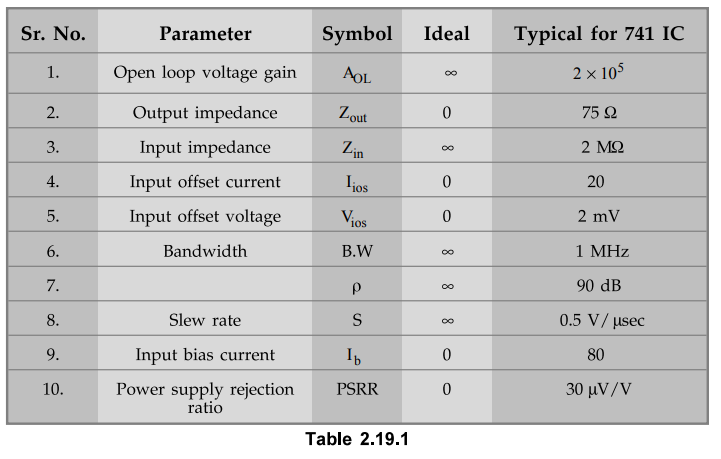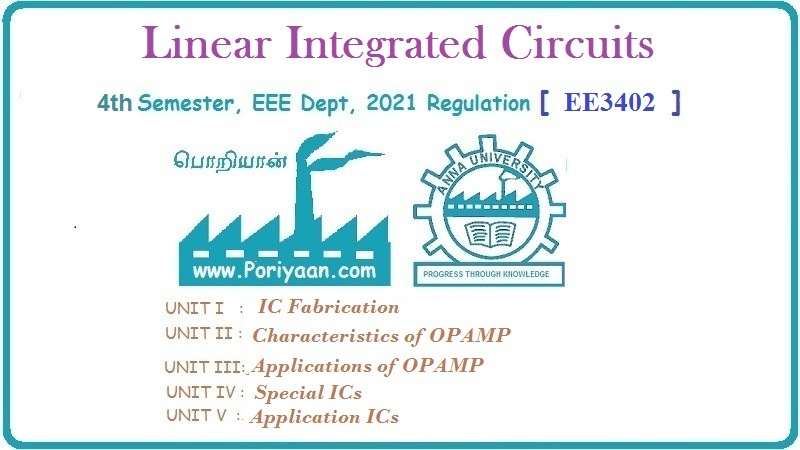Linear Integrated Circuits: Unit II: Characteristics of Op-amp
Op-amp IC 741
Pin Diagram, Characteristics, Parameters, Symbol, Features
A very popular IC version of op-amp is μA741. The manufacturer of pA741 is Fairchild Semiconductor.
Op-amp IC 741
A
very popular IC version of op-amp is μA741. The manufacturer of pA741 is
Fairchild Semiconductor.
Number
of other manufacturers also produced 741 op-amp IC version namely MC1741 by
Motorola, LM741 by National Semiconductor etc. For convenience, this widely
used op-amp IC is called simply IC 741 op-amp dropping the prefixes.
Pin
Diagram :
The
IC 741 is 8 pin IC available in dual in line package (DIP). The pin diagram of
IC 741 op-amp is shown in the Fig. 2.19.1.

The
pins 1 and 5 are offset null pins. These are used to nullify offset voltages
and provide offset voltage compensation.
The
pin 2 is inverting input while pin 3 is noninverting input terminal.
The
output is to be taken from pin 6.
The
pin 4 is for - VEE supply while pin 7 is for + VCC
supply.
The
pin 8 is the dummy pin and no connection are to be made to this pin externally.
Ideal
Vs Practical Characteristics of 1C 741 Op-amp :
The
Table 2.19.1 lists the ideal op-amp characteristics and the typical values of
these characteristics for 741 IC.

Features
of IC 741 :
i)
No frequency compensation required.
ii)
Short circuit protection provided.
iii)
Offset voltage null capability.
iv)
Large common mode and differential voltage range.
v)
No latch up.
Realistic Simplifying Assumptions
We
can make two assumptions which are realistic and simplify the analysis of
op-amp circuits to a great extent. The assumptions are useful and can be used
to obtain the output expressions in variety of linear applications.
1. Zero Input Current
The
current drawn by either of the input terminals (inverting and noninverting) is
zero.
In
practice, the current drawn by the input terminals is very small, of the order
of μA or nA. Hence the assumption of zero input current is realistic.
2. Virtual Ground
This
means the differential input voltage Vd between the noninverting and
inverting input terminals is essentially zero.
This
is obvious because even if output voltage is few volts, due to large open loop
gain of op-amp, the difference voltage Vd at the input terminals is
almost zero.
e.g.
if output voltage is 10 V and the AOL i-e- open loop gain is 104
then
Vo
= Vd AOL Vd = Vo / AOL =
10 / ∞ = 0
Hence
Vd is very small. As AOL → ∞ difference voltage vd → 0 and realistically assumed to be zero
for analysing the circuits.

Thus
we can say that under linear range of operation there is virtually short
circuit between the two input terminals, in the sense that their voltages are
same. No current flows from the input terminals to the ground. The Fig. 2.20.1
shows the concept of the virtual ground. The thick line indicates the virtual
short circuit between the input terminals.

Now
if the non-inverting terminal is grounded, by the concept of virtual short, the
inverting terminal is also at ground potential, though there is no physical
connection between the inverting terminal and the ground. This is the principle
of virtual ground.
Key Point Thus from the
equation (2.20.1), the voltage at the one input terminal of an op-amp can be
realistically assumed to be equal to the voltage at the other input terminal.
This
concept is very much useful in the analysis of closed loop op-amp circuits. The
steps of analysis based on the assumptions are,
Step 1 : Input current of the ideal op-amp is always zero. Using this, the current distribution in the circuit is obtained.
Step
2 :
The input terminals of the op-amp are always at the same potential. Thus if one
is grounded, the other can be treated to be virtually grounded. From this, the
expressions for various branch currents can be obtained.
Step
3 :
Analyzing the various expressions obtained, eliminating unwanted variables, the
output expression interms of input and circuit parameters can be obtained.
Review Question
1. Explain the significance of virtual ground. How would you
explain the existence of virtual ground ?
Linear Integrated Circuits: Unit II: Characteristics of Op-amp : Tag: : Pin Diagram, Characteristics, Parameters, Symbol, Features - Op-amp IC 741
Related Topics
Related Subjects
Linear Integrated Circuits
EE3402 Lic Operational Amplifiers 4th Semester EEE Dept | 2021 Regulation | 4th Semester EEE Dept 2021 Regulation
